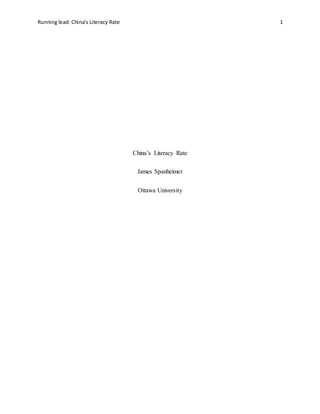Report
Share

Recommended
Recommended
Fake News, Real Concerns: Developing Information Literate Students (December 2019)Fake News, Real Concerns: Developing Information Literate Students (December ...

Fake News, Real Concerns: Developing Information Literate Students (December ...ALAeLearningSolutions
More Related Content
Similar to Spanheimer Final Project
Fake News, Real Concerns: Developing Information Literate Students (December 2019)Fake News, Real Concerns: Developing Information Literate Students (December ...

Fake News, Real Concerns: Developing Information Literate Students (December ...ALAeLearningSolutions
Similar to Spanheimer Final Project (15)
Fake News, Real Concerns: Developing Information Literate Students (December ...

Fake News, Real Concerns: Developing Information Literate Students (December ...
Must comply with all the writing requirements, including APA gui

Must comply with all the writing requirements, including APA gui
Essay Boarding School. Online assignment writing service.

Essay Boarding School. Online assignment writing service.
Dont let yourself get snookered by education statistics

Dont let yourself get snookered by education statistics
Child Discipline Essay. children and discipline essay

Child Discipline Essay. children and discipline essay
Spanheimer Final Project
- 1. Running lead: China’s Literacy Rate 1 China’s Literacy Rate James Spanheimer Ottawa University
- 2. 2 China’sLiteracyRate Abstract Population mean is discovered in correlation to the International database with relation to the literacy rate in China. The literacy rate of China compared to other BRICS (Brazil, Russia, India, China, and South Africa) countries is also analyzed.
- 3. 3 China’sLiteracyRate China’s Literacy Rate Introduction The literacy rate for China at 81.5% does seem like a somewhat low number for what is considered to be one of the world’s truly major superpowers. Comparing it directly with the United States and Russia, who have 97 and 98%, respectively, is somewhat indicting. However, comparing China’s literacy rate with the other BRICS nations, which are characterized as the up and coming countries, paints a much more representative picture. I want to look at the literacy rate of the Chinese with relation to the entire International database and also the BRICS countries using population mean. This will show if China is truly lagging behind among the other developing nations. Problem Statement The literacy percentage in China is significantly lower than most other nations listed in the International database. This could be due to a number of different factors, according to UNESCO’s Ross (n.d.) who stipulates that education being rural, there existing gender preferences for males to be educated primarily, the sheer huge population, and the alarming amount of disabled students in China are reasons for the literacy rate not being as high as the U.S., for instance. ResearchQuestion What is the population mean for the International database literacy rate in relation to the literacy rate for China?
- 4. 4 China’sLiteracyRate Hypothesis Ho: The literacy rate for China is less than or equal to the population mean for the International database. H1: The literacy rate for China is greater than the population mean for the International database. For the sources used in researching this topic, I discovered a terrific Social Venture Group blog (2009) which led me directly to the UNESCO report in which there is excellent work done as to not only literacy figures in China by decade but also some reasons why their literacy rate has actually increased nearly double since 1959. I use the blog merely as a guideline, not a verbatim source for this paper since it is another individual’s interpretation of the data included in the Ross China UNESCO report. Definitions In this study I will be using several groups of data in order to solve the problem in question. These are: the sum of all values in the population, the number of values in the population, the actual literacy rate of China, and the population mean, which is defined as the sum of values divided by the number of values in the population. Presentation of Data In order to determine whether the literacy rate of China is greater than, equal to, or less than the population mean of the International database and also the BRICS nations, the following formula will be used:
- 5. 5 China’sLiteracyRate Sum of all values in the population = 4109.5 Number of values in the population = 46 Population mean = 89.3 Literacy rate of China = 81.5 Sum of all values in the population = 395.9 Number of values in the population = 5 Population mean = 79.2 Literacy rate of China = 81.5
- 6. 6 China’sLiteracyRate Conclusion, Implication, and Recommendations The null hypothesis is accepted, as China’s literacy rate of 81.5% is found to be less than the population mean of the International database, which is 89.3%. At first this struck me as precisely what I was expecting. I wanted to look deeper, and found that compared to the BRICS nations, China’s 81.5% is actually greater than the population mean from those countries’ 79.2%. India severely skews both results with its 37.3 deviation on the International database and 27.2 with the other BRICS nations, but China actually holds steady which is both surprising and not unexpected. It’s somewhat eye-opening considering the sheer massive population that China has of almost 1.3 billion people, but the majority of them live in metropolitan areas where literacy will enable one to support themselves financially and illiteracy will earn somebody a much bleaker outlook. With China rapidly inching closer to overtaking the U.S. as the world’s predominant superpower, I can only prognosticate that the literacy rate of China will climb until it comes close to or surpasses the International population mean. I’ll be very interested to look at this database again in ten years.
- 7. 7 China’sLiteracyRate References ChinaPhilanthropy.(2009,July24). Social VentureGroup. http://blog.socialventuregroup.com/svg/2009/07/literacy-in-china.html Marchal, W.G., Lind, D.A., Wathen, S. A. (2012) Statistical Techniques in Business & Economics (15e). New York, NY. McGraw-Hill Irwin. Ross,H. (n.d.) ChinaCountryStudy, UNESCOGlobalMonitoring Report. http://portal.unesco.org/education/en/files/43542/11327151221Ross_China.doc/Ross_China.doc